Cloud Adoption: Here Is the Best Way of Doing It

Cloud services are a fast, secure, convenient, and economical way to conduct business that determines their popularity among companies of all sizes and industries.
However, each organization takes its approach to cloud adoption. While some are successfully implementing software-as-a-service solutions or adopting cloud strategies for new systems, others are trying to migrate most of their enterprise systems to the cloud.
But don’t confuse a simple IT migration to the cloud with an overarching transformation strategy needed to take full advantage of this technology. Moving to the cloud alone does not make you a winner. Moreover, this approach can lead to IT architectures becoming more cumbersome and more expensive than before.
You cannot reveal the full value of the cloud through one-off tactical decisions. You need to create and implement a holistic digital transformation strategy instead. It includes adopting modern security measures, standardizing and automating the IT environment using an open API model, operating in an automated agile operating model, and leveraging new opportunities to deliver innovative business solutions.
While the cloud is not a prerequisite for these advances, it can significantly facilitate digital transformation. Companies that are good at adopting the cloud bring new products to market much faster, innovate more easily, and scale their businesses more efficiently while reducing technology risk.
As a company providing cloud-based services for many years, let us explain the basic principles that you must follow to profit from cloud technologies and systems.
The state of the cloud by the numbers
Obviously, the business world needs cloud services, and statistics confirm this. The global crisis related to COVID-19 served as a de facto catalyst for the development of the cloud computing market, as evidenced by the surge in the worldwide adoption of cloud technologies in various industries. Analysts predict that the global public cloud services market will grow fast and reach $623.3 billion by 2023.

Public cloud infrastructure grew 35% in 2021, and 83% of enterprise workloads were migrated to the cloud, with 21% of organizations using over three different cloud platforms. By 2025, the volume of data in cloud data centers will exceed 100 zettabytes.
Cloud providers are constantly increasing the volume and quantity of cloud software development services they provide. Common public clouds such as Amazon Web Services, Microsoft Azure, and Google Cloud Platform are becoming more popular than ever. Capital One launches a bank’s mobile application on AWS; GE Oil & Gas has moved most of its storage and computing resources to the public cloud. Maersk migrated their legacy systems to reduce costs and operational risks and provide advanced analytics to streamline operations.
Forward-thinking organizations are also actively looking for ways to leverage new cloud services to create innovative business solutions. Progressive Insurance deploys its Flo chatbot in the public Cloud; NASCAR uses machine learning solutions to analyze real-time and historical data to improve performance and simulate scenarios.
Even digital-native companies that have built their own IT infrastructure and systems over the years are now choosing to move to the cloud for higher scalability and functionality. Spotify is a better example of this.
Why do companies choose cloud?
Cloud computing, or remote servers hosted on the Internet, are used to store, manage, and process critical data while leveraging the technology resources of the public cloud to run applications. It provided access to cloud services within one of the following services:
- Software as a Service (SaaS). Companies access the software without downloading it and use it on their local computers. Examples include Microsoft Office 365 and Adobe Creative Cloud.
- Platform as a Service (PaaS). The full cloud computing model becomes available to companies and software, hardware, and infrastructure services. Examples include Microsoft Azure and Google App Engine.
- Infrastructure as a Service (IaaS). Here, companies are provided with a development environment, secure data storage, tools for developing and testing software, and monitoring functionality. Examples include Oracle Cloud Infrastructure and Amazon Web Services.
- Serverless computing. The aim is to build application functionality without managing the servers and infrastructure required. The cloud provider handles the configuration, capacity planning, and server management for you. Serverless architectures are highly scalable and event-driven and only consume resources when a specific function or trigger is executed.
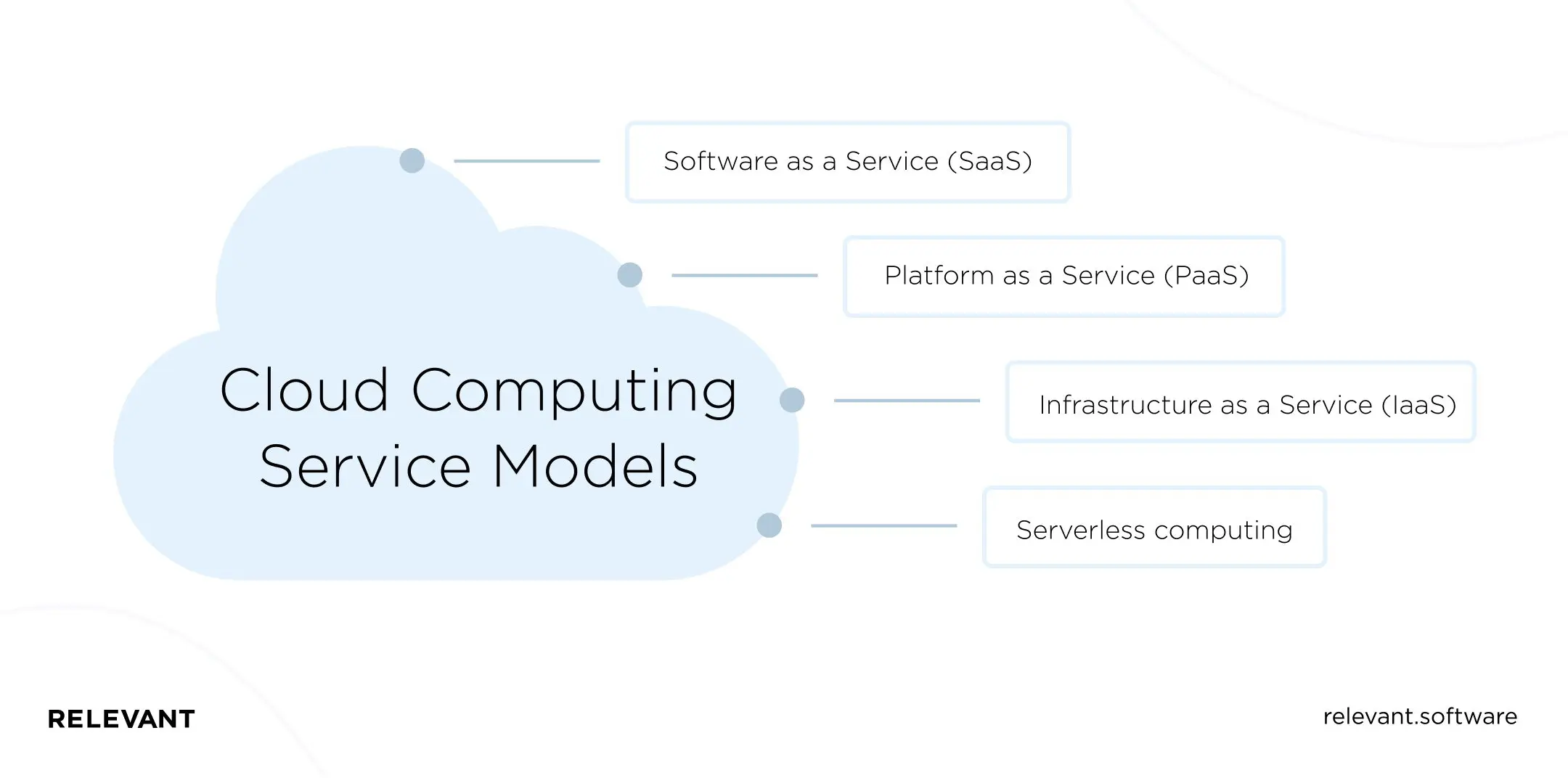
Customers also gain access to private, public, or hybrid networks.
What are the benefits of cloud computing for your business?
Cloud adoption brings many benefits to your business. You get a kind of virtual office and can flexibly connect to your data anywhere and anytime. Let’s take a look at all the advantages:
Sustainable business operations
Cloud computing can play a crucial role in business resilience as it provides 99% uptime with no risk of failure. Whether you are facing a power outage or other problem, storing your data in the cloud will keep it backed up and protected in a safe place. The ability to access your data allows you to do business as usual, minimizing downtime and lost productivity.
It offers you flexibility, so you can quickly scale up or down the scale of operations and storage needs to suit your current business needs. Additionally, your service provider performs all the updates, which allows your business to save time and money.
Clouds provide seamless data integration during mergers and acquisitions, launch new products or services without spending money on system support, and use the latest technologies and tools to grow a tech-savvy enterprise.
Reduced capital expenditure
In the case of the cloud, there is no need for any in-house infrastructure equipment as all network and storage infrastructure is accessible from the data center. The company does not need to spend money on upgrading hardware and purchasing software licenses for a limited period because the cloud provider provides all the necessary infrastructure and resources (hardware and software).
Resources are available on-demand, and excess resources can be reclaimed, reducing costs. Likewise, a company cannot spend money hiring IT staff to maintain infrastructure.
Increased collaboration
Cloud computing makes collaboration so easy. Your team members can effortlessly and securely view and share information through the cloud platform. Some cloud services even provide collaborative social spaces for your employees to connect, which helps them stay interested and engaged. Collaboration is possible without cloud computing adoption, but it will never be so simple and efficient.

Better customer service
High-quality customer service is critical to the success of any business. Adopting cloud technology often plays an important role in achieving this goal, as it keeps your customers connected with your company.
Most cloud companies actively resolve support requests and also have uptime Service Level Agreements to ensure system availability at all times. In addition, customers will contact the staff for questions or instant feedback easily. This real-time communication helps companies receive timely feedback, critical to your business’s success.

Who needs to adopt cloud – and why?
Let’s check who needs cloud computing and who benefits from cloud storage and applications the most.
Startups: start with lower costs
Young entrepreneurs and startups can save significant upfront costs with cloud computing by eliminating investing in massive or complex IT infrastructure. The cloud also keeps them from upfront software investments. Most major software providers now offer SaaS for their popular business programs, so instead of buying software and licensing for one or more workstations, you can simply pay a monthly fee and use them fully.
Small and medium-sized companies: IT that grows with you
Any expanding business can face growth challenges. As an organization grows, more complex applications and more space are required. Traditionally, business expansion has meant disruptive and costly hardware and software upgrades.
Cloud computing makes upgrading your IT infrastructure quick and inexpensive. Since you only pay for the space and services you need, it’s just a matter of adding additional components through your cloud provider. You can also delete services if you find that your company no longer needs them without paying penalties or fees. Since cloud adoption does not require software installation, the entire process takes minutes, not days.
Large corporations: big savings for big players
The larger the company, the more it invests in IT. Large enterprises and corporations can achieve significant savings by migrating to partial or full cloud environments. Besides the usual defendants, cloud platforms can contain cloud computing business applications that many large companies need. That not only saves server space but also helps companies operate more efficiently.
Cloud environments are not tied to business hardware, so employees and managers can access their work from the office, home, or even through smartphones or tablets. Using cloud computing also saves money on dedicated IT staff, as the cloud host handles all hardware, including maintenance and security.
How to make your cloud adoption journey smooth?
Cloud adoption is a strategic enterprise used to improve the scalability of database capabilities on the Internet while reducing costs and risks. However, remember that you can only realize these cost-effective benefits if you have the right strategy, planning, and management structure for your cloud deployment.
Which cloud model to choose?
Choosing the right cloud adoption model to meet your organization’s unique needs is paramount. Here are five existing models and their capabilities:
- The hybrid cloud approach, adopted by nearly three out of four enterprises that have moved to the cloud, uses on-premises infrastructure or a private and a public cloud such as Amazon Web Services (AWS) or Microsoft Azure.
- The multi-cloud adoption – distributes the same workloads across multiple public cloud providers, with or without an existing private cloud. That avoids vendor lockdown, provides more flexibility, and shares the risk of disruption between vendors.
- The poly-cloud approach developed from multi-cloud enables organizations to distribute different workloads across different cloud providers, leveraging their strengths. For example, an organization can use AWS Cloud for standard services and Google Cloud for machine learning and data-driven applications.
- Industry cloud – is a wide range of industry-specific cloud services, applications, and tools optimized for specific industry use cases. For example, Microsoft and SAP have teamed up to provide SAP supply chain solutions for manufacturing through Microsoft Cloud.
- Distributed cloud – brings cloud capabilities to different physical locations – Cloud service providers maintain and leverage capabilities but physically operate at the point of interest (near the source). Common styles developed from 5G, and Edge convergence include Edge Cloud and Metro-Area Community Cloud.
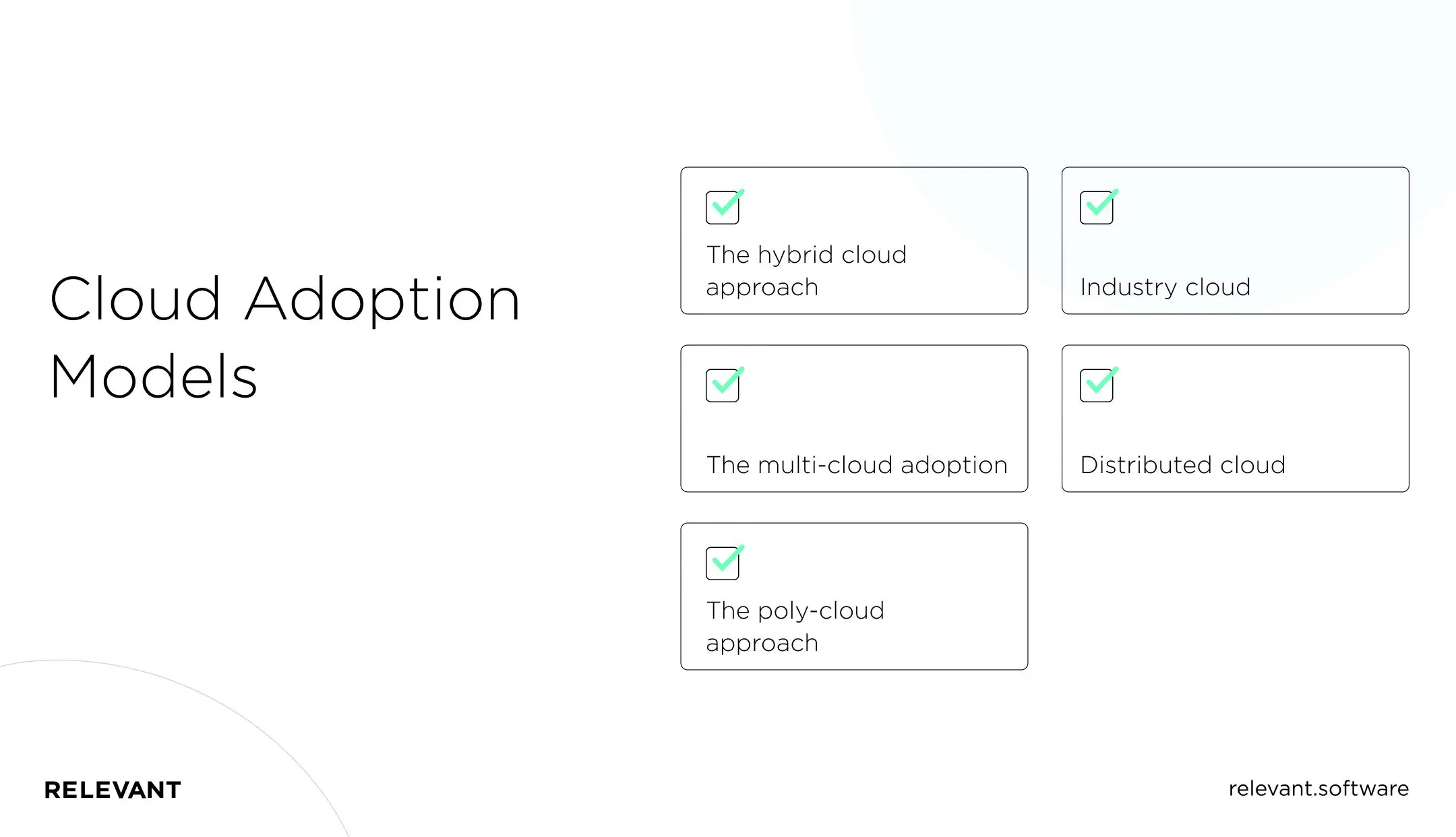
Cloud adoption: 5 common challenges
We cannot deny that some organizations remain concerned about some aspects of cloud adoption. Some of them are exaggerated, some are valid. But in any case, you can overcome them with the right strategy.
Security and privacy
Companies moving to the cloud are concerned about confidential company and customer data security. What can we say if even 66% of IT professionals consider security a serious obstacle to cloud adoption?
But public cloud providers invest much more in their security than any single company or government agency. For example, Microsoft invests $1 billion annually in cybersecurity for its Azure Cloud platform, which successfully defends against 7 trillion cyber threats a day. Amazon and Google are investing equally to keep personal and corporate data safe. Therefore, moving to the cloud does not reduce security but increases it.
Vendors lock-in
Vendor lock-in remains a major issue for many companies. Entrepreneurs worry that migrating all systems to the cloud will tie the company to the same vendor. That is especially important given the steadily declining cost of cloud services worldwide. Jeff Bezos, a founder of Amazon, formulated Bezos’s Law, which states that the cost of cloud computing is halved every 18 months.
Implementing a multi-cloud solution is the most popular way to resolve this issue. If the systems are hosted on multiple cloud platforms, the transition between service providers will be more workable.
Governance and compliance
Corporate governance and compliance issues are major concerns for businesses. 39% of them said this is one of the barriers to public cloud adoption.
Some of the governance challenges include a lack of accountability, a lack of a planned disaster recovery process, a failure to implement cloud compliance best practices, and a lack of training. Cloud compliance gets even more challenging in highly regulated sectors like healthcare, where businesses must strictly adhere to regulations like HIPAA.
Enterprises must ensure that their cloud strategy follows agreed procedures and policies and aligns with overall business strategies. They need to bridge the gap between using the public cloud for storing and backing up data and complying with industry regulations to keep their businesses secure.
ROI
We can break down cost concerns into several areas of focus: implementation, structure, and ROI. We do not consider the costs of implementing the cloud, as they accompany any technology implementation.
What is different is the cost structure over the life of these solutions. While on-premises technologies typically require a one-time upfront investment, the SaaS model is based on recurring costs. However, this shouldn’t be a problem; it’s just a matter of preparing for the difference. But “hidden” costs associated with on-premises technologies (like maintenance, upgrades) disappear into the cloud. Eliminating capital costs means cloud computing is cheaper in the long run.
Well, ROI depends on how you built your cloud strategy and whether you have a strong business case for making this or that decision. But if you do, the ROI on your cloud investment is real.
Skill gaps
One of the challenges in cloud adoption is the lack of skills. According to a 2020 PwC survey, 77% of organizations planning to move to the cloud complained about their absence.
Therefore, companies must either build their cross-functional cloud team or attract a cloud adoption partner to take on the cloud adoption framework and infrastructure and personnel costs to implement a cloud strategy. (Take a look here if you don’t know how to hire a DevOps engineer).
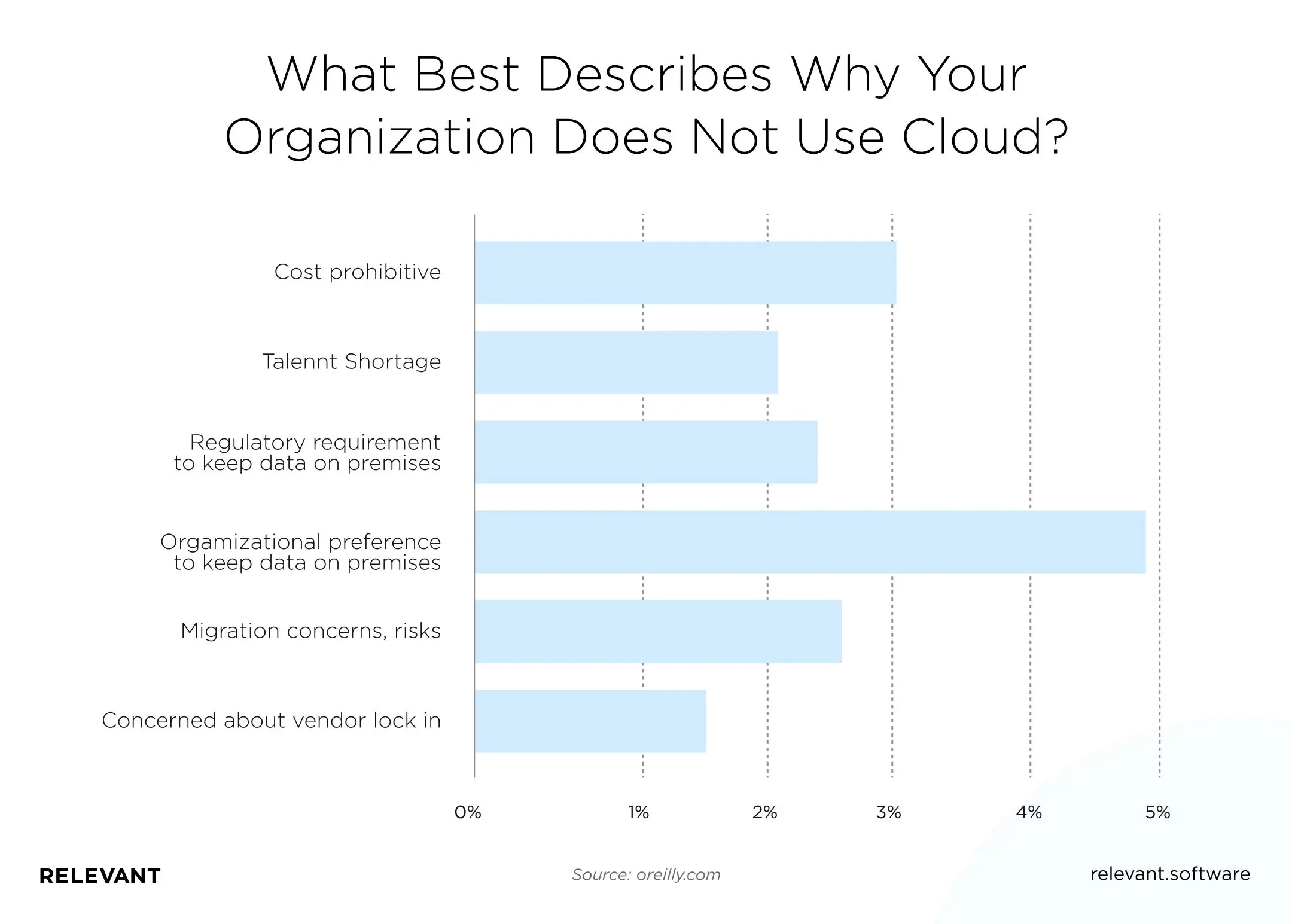
Moving to the cloud as a unique journey
Companies are moving to the cloud to deliver a seamless service to their customers, improve operations, and stay competitive by providing value faster and more cost-effectively. The right cloud initiative can radically change (and improve) the way a business operates, but only if done right.
Cloud adoption strategy tips
Moving to the cloud is an iterative process. But since there is no one-size-fits-all approach, each organization must independently build a strategy to implement cloud services.
Continuous delivery of custom code
Every business now strives to compete with digital services that help them better interact with customers and lower costs. These digital services require constantly growing software, which defines the requirements for agile development and DevOps practices. DevOps is about continuous code changes, requiring an immediate deployment infrastructure, ideal for IaaS and containers. Therefore, continuous delivery is paramount to a cloud strategy.
Decide on cloud migration priorities
For off-the-shelf applications, the question is whether to move them to the cloud or store them in the organization’s own data center. That reduces costs, but it does not work for every application.
Flexibility is the key to cost savings. That means that you should prioritize applications with highly variable usage for migrating to the cloud. Otherwise, you pay for on-premises resources you don’t need, or you struggle to expand the capacity of your virtual machine or provide other means of increasing your infrastructure. Besides cost savings, the following aspects of application migration need to be considered:
- What impact does remote workload start have on interdependent applications?
- Are there workloads that cannot be constrained for cloud migration?
- Is the app suitable for serverless computing?
- Does the app need the flexibility that the cloud offers?
Manage your overall strategy
The cloud is not only a technology but an operating model. Have you customized your provisioning and management processes to accommodate a hybrid approach? Do operations have a way to understand workload configurations, including who owns them, where they run, and how they are updated?
Therefore, the security team must understand what the cloud provides and what policies must be managed internally, both in risk and compliance. Typically, you should provide at least identity and access to controls. Centralizing all cloud access can make this easier, but it is even easier to use the same access method for all applications in an organization.
SaaS for non-revenue applications
SaaS is an area that should be considered an alternative delivery method for apps that are not key to generating revenue. Email, CRM, helpdesk, and payroll are common across most businesses, but today there are SaaS options for just about any software. By outsourcing non-core applications, IT can focus on what makes it competitive.
Legacy applications remediation
If your legacy applications are not doing their job, then the transition to the cloud solution is not in doubt. But what if your legacy apps are still running? The benefits of replacing such applications are only worth the cost if you cannot find the talent to manage them, or a genuine security threat can affect their availability.
Otherwise, the software will allow you to deploy legacy applications to new platforms, including IaaS. Today, it is also possible to automatically move apps from virtual or physical servers to the cloud.
Automating these migrations is crucial to test the approach and minimize downtime and data loss during failover while reducing migration costs. The key is to align the migration schedule with major updates or app replacements and make basic decisions (such as API) to make the fix easier.
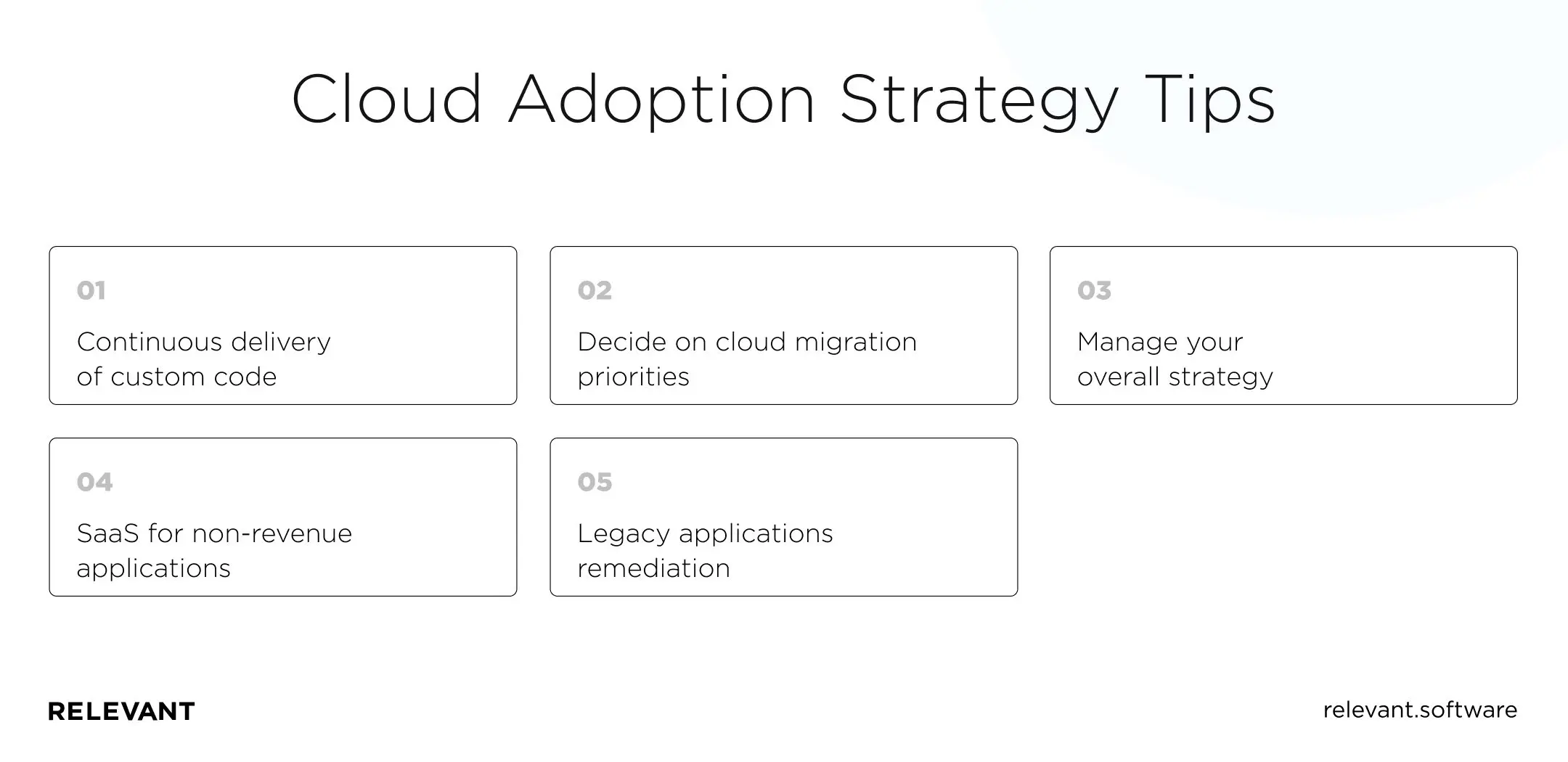
How to implement cloud strategy?
We’ve also summarized the six phases you need to take to implement your cloud strategy.
- Assessment. At this stage, you assess the impact of implementing the strategy in three areas; cost, architecture, and safety. It is crucial to seek professional help for the assessment. If the result shows your business can handle the switch easily, move on to the next step.
- Proof of concept. In this phase, you create and pilot a cloud strategy in your organization. Take time to introduce it to your team and build support among them.
- Data migration. You use the available storage options to find the most secure option within your budget range. After making sure that your data is intact, you can move it to the cloud;
- Application migration. You need to select the type of migration that your organization needs to adapt. That can be a strategy, where you move everything to the cloud servers, or a hybrid approach, where some functions are transferred to the cloud, and others remain on the organization’s servers.
- Leveraging the cloud. In this phase, you use the tools offered by the cloud framework to scale your functions automatically. Cloud servers provide high elasticity and scalability that you should use to maximize the benefit to the organization.
- Optimization. That is where you now tune and optimize the system to make optimal use of available resources, monitor performance to ensure early detection of anomalies, and re-engineer where the cloud transition is not working as expected.
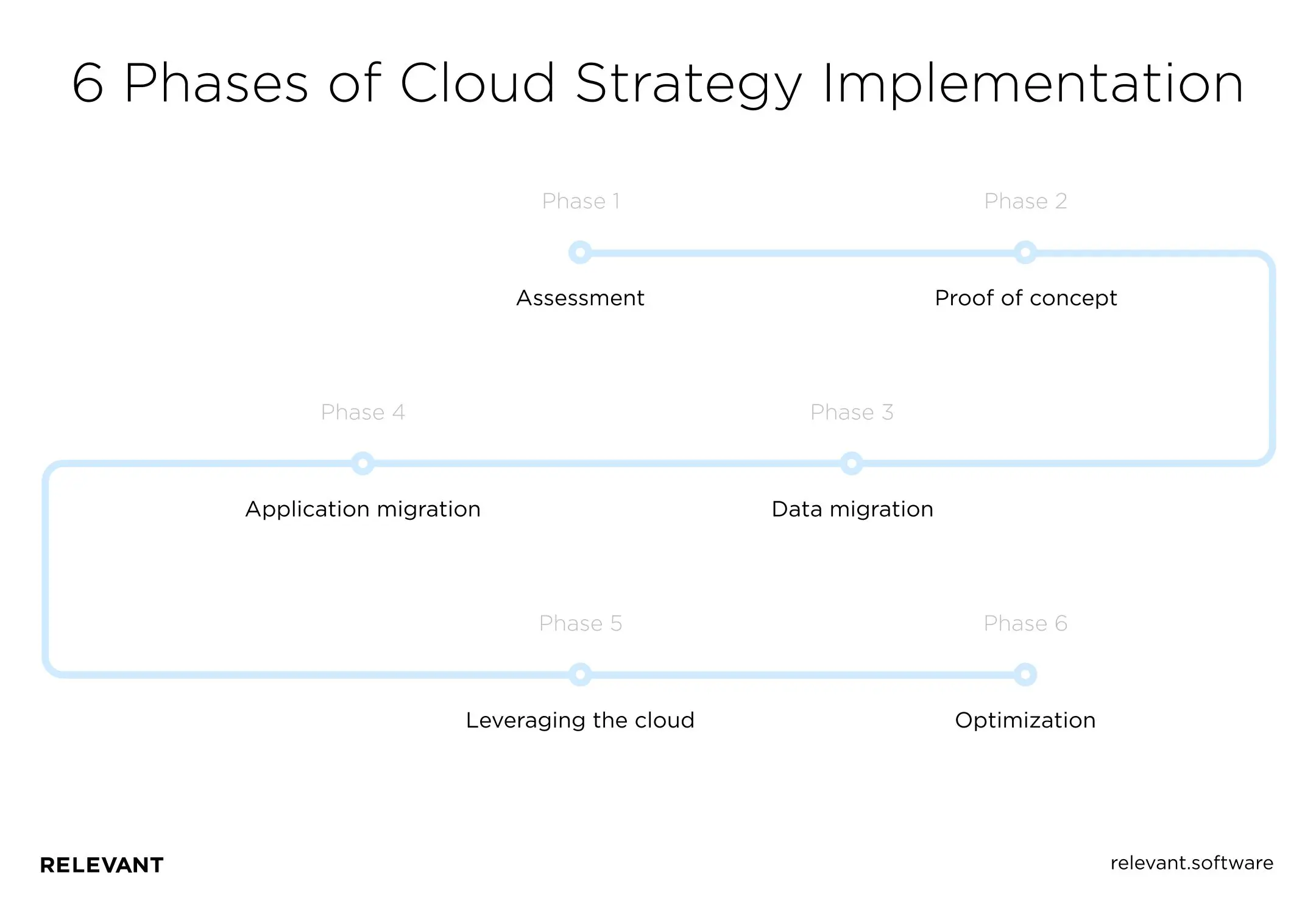
Why Relevant?
As a trusted outsourcing SaaS development company, we at Relevant have been helping our clients get the most out of their cloud adoption for many years.
Typically, cloud deployment occurs in the following sequence:
- We will help you develop a plan by closely looking at your business requirements and how you define successful outcomes. In addition, we will analyze the technical requirements to support these business outcomes, examine the applications and all dependencies, and summarize the cloud readiness assessment for applications in bulk.
- Once you have approved the strategy and roadmap, we will help you choose the best platform(s) for your applications. We will also look at the specifics of using multiple clouds.
- Next, we will help you design and implement your solutions. We’ll start with basic cloud design and deployment (including security, identity, access control, networking, and other elements needed to build a solid foundation). Once your cloud landing zone is ready, we’ll help you determine how best to migrate your applications, develop orchestration and automation strategies (both in the cloud and across platforms).
- Once your workloads are up and running in the cloud, we’ll help you with ongoing management and optimization. We will continually compare your deployment against your cloud provider’s ever-changing best practices and look for opportunities to modernize your applications further.
So, if you are interested in cloud adoption by DevOps services and want to hire DevOps engineers, Relevant is here. We provide all software development services that today’s companies need to quickly expand their market presence and innovate.



